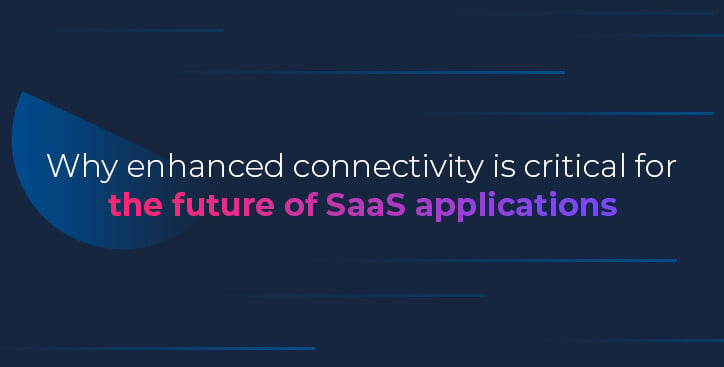Software as a Service (SaaS) is growing at a rapid rate with businesses increasingly reliant on cloud-based solutions. According to the 2024 State of SaaS Growth report, organisations globally now use an average of 371 SaaS applications. This surge in adoption means that IT leaders are tasked with managing a more complex environment, which comes with a suite of challenges. To ensure the performance, security and reliability of these services, network connectivity is critical. In this blog, we’ll explore the key trends shaping the SaaS industry, the challenges that accompany them, and the essential role of enhanced connectivity in supporting these applications.
Key trends in SaaS
The continued adoption of SaaS applications sees several emerging trends that are shaping its future, each bringing great benefits but also challenges to manage.
- AI and automation: The integration of AI and automation into SaaS offerings is revolutionising business operations. From enhancing analytics to improving customer service, these technologies are driving significant efficiencies and providing businesses with deeper insights into their operations.
- Vertical SaaS: Tailored solutions designed for specific industries, such as healthcare and finance, are gaining traction. These vertical SaaS offerings deliver specialised features that address the unique needs of particular sectors, offering more value than generic solutions.
- Multi-cloud strategies: To avoid vendor lock-in and enhance resilience, organisations are increasingly adopting multi-cloud approaches. By leveraging multiple cloud providers, businesses can distribute workloads more effectively, improving redundancy and enhancing resiliency.
- Security: With cyber threats only rising, securing SaaS environments is now more critical than ever. SaaS security investments are increasing, where Statista found that organisations increased budgets by 39% in 2023. This is to ensure sensitive data is protected whether it is stored on-prem, in the cloud, and while it is in transit.
Security considerations in SaaS adoption
The need for robust security measures is evident. Gartner predicted that by 2025, 45% of organisations globally will have experienced attacks on their software supply chains, triple the amount in 2021. Entrusting sensitive data to external SaaS vendors exposes the data to supply chain risks that may lead to data breaches. As organisations evaluate their security strategies, especially when considering public or private cloud solutions, it's crucial to address the trade-offs. The public cloud offers greater agility, but with it comes higher security risks. To mitigate these risks in public cloud environments, the following security services may be necessary:
- Anti-DDoS: The measures and technologies designed to detect, mitigate, and prevent Distributed Denial of Service (DDoS) attacks, which overwhelm a target's resources with excessive traffic to disrupt services.
- SIEM (Security Information and Event Management): A system that collects, analyses, and correlates security data from various sources in real-time to detect, respond to, and manage security threats within an organisation.
- MDR (Managed Detection and Response): A cybersecurity service that provides continuous monitoring, threat detection, and incident response through a combination of technology and human expertise to protect organisations from advanced cyber threats.
Performance and reliability challenges
Additionally, as SaaS applications are predominantly used over the public internet, there are several performance and reliability challenges that can significantly impact the user experience:
- Latency and response time: SaaS applications require low latency to ensure quick response times, especially for real-time applications like video conferencing and financial trading platforms.
- Downtime and availability: High availability is critical for SaaS applications. Downtime can result in lost productivity, revenue and customer trust.
- Lack of visibility: Comprehensive visibility is important to monitor user activity and assess application performance. Poor visibility may lead to inefficiencies and service disruption.
- Bandwidth limitations: Insufficient bandwidth can lead to slow application load times and a reduced user experience, particularly for media-rich applications.
Enhanced connectivity: Ensuring SaaS success
Given these challenges, enhanced connectivity is essential for ensuring the protection, performance and reliability of SaaS applications. Here is how NaaS platforms such as Console Connect can provide a more agile, scalable and secure way to manage your applications and data:
- Enhanced data protection: Instantly respond to threats by rerouting suspicious traffic to scrubbing centres, which have successfully mitigated attacks up to 2Tbps with capacity to spare. Plus, safeguard sensitive information by using a private network infrastructure, avoiding vulnerabilities associated with the public internet.
- Optimised performance: Benefit from higher throughput, lower latency, and superior network efficiency with dedicated Layer 3 connections to SaaS platforms, and Anti-DDoS protection using our own global IP network (AS3491), which is ranked in the top ten globally.
- Reduce complexity: Simplify your end-to-end network management with real-time connectivity monitoring to prevent downtime and service disruption.
- Increase network reliability: Avoid public internet bottlenecks and enjoy SLA-backed performance for mission-critical applications.
- Flexibility and control: Dynamically adjust bandwidth in real-time to meet the needs of your customers via our self-service portal, giving you full control over how you provision, pay and manage our services.
The SaaS landscape is evolving rapidly and will only continue to do so, presenting both opportunities and challenges for IT leaders. As businesses continue to adopt more SaaS applications, it is imperative to understand the emerging trends, and know how to implement the relevant strategies to address security, performance and reliability challenges.

